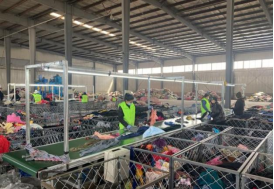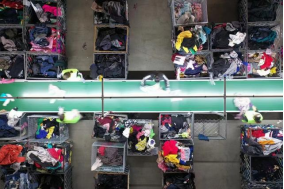Product Show
The old clothes you throw away are used as "treasure" in Africa.
Africans buy tens of thousands of tons a year, and ladies' underwear sells best
Before reading this article, we sincerely invite you to click on the "attention", convenient for you to consult a series of quality articles at any time, and easy to discuss and share, thank you for your support ~
One day in February 2023, a Chinese businessman and a local translator came to a clothing market in Madagascar. The Chinese businessman came here to do a market research.
When he entered the market, he found that the crowd was crowded and every clothing stall was very good.
He also asked about the prices of several stalls, most of the clothes are converted into RMB in about dozens of yuan, there are also particularly cheap.

And these clothes are second-hand clothes from all over the world, many of which are shipped from China.
From new clothes to old clothes
Madagascar is a poor country in Africa, not only this one country, in fact, many African countries have a huge second-hand clothing trading market.
In these markets, the clothes, pants, shoes, socks and so on at each stall are piled together.
Some of the newer, better quality or famous brands are hung on shelves.
Every day, come to such a second-hand clothing market to buy clothing customers are very much.

Especially before the outbreak of COVID-19, such a trading market was bustling with people every day, and its trading volume was also considerable.
In Africa, in addition to the poor people, there are a large number of ordinary office workers will also come here to buy clothes.
A Chinese blogger once spent about 100 yuan to find seven pieces of clothes in such a market.
Speaking of buying and selling old clothes, we may now think of some second-hand goods replacement website or APP, in these channels, most of the transaction between individuals.
And the quality and color of these old clothes are better, and the price is not so cheap, including many big brands or luxury brands.
In China, there was once a saying: three years, three years, another three years, that is to say, a dress has to be worn for more than ten years, but this is a thing in the past.

After the reform and opening up, China's light industry has developed rapidly, and the overall national economy has also been greatly improved. Nowadays, many urban residents no longer wear old clothes.
People's requirement for clothing has developed from simple warmth to beauty and fashion, so people will buy new clothes every quarter or even every month.
The development of the network and logistics industry has greatly stimulated the purchasing power. Now there is no need to buy a dress or go to the store. Whether it is very convenient to buy or return through the Internet.
So a lot of people change their clothes at home, so what about a lot of old clothes?
If you simply treat old clothes as garbage, there are two disadvantages, one is huge waste, the other is environmental pollution.

So there is a better way to dispose of old clothes, which is to recycle them and then sell them. China's old recycling is already a huge industry, but in fact the recycling rate of old clothes is less than 10%.
In fact, those old clothes that people do not need can not be counted as garbage, even if it can not be used as clothes can also be used as raw materials for many products, such as mops, gloves, thermal insulation cotton, sound insulation cotton and so on.
According to relevant statistics, about 70% of the old clothes are currently used for production and reuse, and the remaining 30% will be exported to other countries after processing.
The recycling of old clothes has become a huge industry, and its huge commercial value can promote people's employment and economic growth.
In recent years, many people have also found the business opportunities contained in this industry, and the related procurement, sorting, packaging and export industrial chains are becoming more and more mature.
There are many poor countries in the world, among which the poor countries in Africa are the most, and many of the second-hand clothes exported by China are sent to African countries.

In Africa, most people have no psychological barriers to buying old clothes, even including intimate clothing. A large number of second-hand clothes imported from China are the best choice for cheap and good quality.
Now there are many people engaged in the export of old clothes, so how does this industrial chain work? How much is the profit?
Next, let's take an old clothing recycling enterprise in Shandong province as an example to take a look at the details.
This enterprise has a medium volume, the annual turnover can reach more than 50 million yuan, has a certain influence in the industry.
From China to Africa
In their daily lives, people have disposed of old clothes, either in garbage bins or in recycling bins, or sold to door-to-door vendors.

Generally speaking, the price of recycling old clothes is about a few cents a kilo, and when they accumulate a certain weight, they will sell them all to large recycling stations.
This large recycling station has a certain inventory capacity, but also has a preliminary sorting capacity.
After the initial treatment, the profit of the old clothes can reach 400~800 yuan per ton. Large recycling stations will supply these goods to downstream factories, and the more they are purchased, the cheaper the price.
The kind of clothing is different, the price is also different, generally speaking, the price of summer clothing is the highest.
The Shandong factory exports about 2,000 tons a month, offering summer prices of up to 10,000 yuan per ton, and shoes ranging from 3,000 to 70,000 yuan.
The old clothes must first be sent to the sorting workshop of the factory, where there is a sorting line and packing area.

The sorting line is a belt that can be driven slowly. After the old clothes are disassembled, they are all stacked on the belt. The sorting workers are located on both sides of the assembly line to classify the clothes.
Although it is second-hand clothing, but as an export product also has the standard requirements and specifications.
First of all, these clothes must be intact and undamaged, second, there are no stains, and third, they can not affect the second wear. So each piece of clothing is checked by the workers and then packaged in a different category.
The sorting workers will put all the clothes into different containers, such as jeans, shirts, T-shirts, scarves, shoes, underwear, and so on. This classification is very detailed and adds up to more than 100 kinds.
Then the quality inspection staff will check the clothes, if there are not meet the requirements, they will be picked out scrapped.

The second-hand clothes are priced by weight, so they are weighed before packing.
Hydraulic packaging opportunities are used to compress the clothes into cuboids according to the customer's requirements, and the weight of each pack is also determined by the customer. There must also be a list indicating the type and weight of the clothing.
The packaged goods can be processed for export business, and the clothes will be sent to Kenya, Madagascar, Ghana and other countries in Africa.
Secondary wholesalers in Africa, after getting the goods, do not open the retail goods, but distribute them in "packages".
Usually, the packaged bags are only disassembled when they arrive at the vendors in the second-hand clothing market.
For these vendors, buying such a big bag is a bit like opening a blind box, and each bag of clothes can bring them a different profit.

Experienced vendors will grade all their clothes again after unpacking them.
Different grades of clothing, the price is naturally different, expensive may be about dozens of yuan, cheap or even only need a few yuan.
Of course, the first customers to pick better clothes, so in the second-hand clothing market in Africa, people often see the unpacked clothes.
When they sweat out of the crowd, they usually hold several clothes in their hands.
Many African housewives are very satisfied with the clothes because they are little to buy several sets of clothes for their children.
Most buyers for the quality of the requirements of clothes are not high, strong and durable wear is not broken, although some people will buy more expensive products, but the main demand of most buyers or: cheap and good quality.

Therefore, according to customer demand, Chinese export enterprises will also adjust the structure of goods.
And the vendors in the market also need different levels of clothing to meet different customers, so they will choose different prices.
A large number of old clothes are exported to Africa, in addition to China, the United States and Britain and so on.
China's textile industry is very developed, and the second-hand clothes exported from China are cheaper than those exported to the UK and the United States, and the quality is quite good, so many buyers from African countries prefer to import second-hand clothes from China.
More and more people see this business opportunity, and one after another has invested in this industry.
Some fairly mature practitioners have also made a lot of profits, and an exporter said that under normal circumstances, his daily profit can reach about 200,000 yuan a day.
status of industry
Starting in 2017, Tanzania, Rwanda and Uganda have announced a plans to stop the import of second-hand clothing from abroad.

This move is mainly to promote the domestic textile industry, so is the export of second-hand clothing business to the bottleneck? It doesn't seem true.
Africa has more than a billion people, most of whom are poor. Moreover, African countries have low light industry productivity, and their own production capacity cannot meet the needs.
Therefore, there is still a huge market and a good prospect for the export of second-hand clothing to Africa, but with the regulation of the market and the participation of more competitors, the scale requirements of this business are also higher.
For Chinese exporters, the supply of goods is a big problem.
Summer clothing is clearly more popular in Africa because of the climate.
Some of the better quality and trendy summer clothes can be sold to 20,000 yuan per ton, but because the recovery rate of a large number of second-hand clothing in China is not high, so the supply is not relatively not sufficient.

Now there are a lot of specialized old clothing recycling platforms, including Taobao, Jingdong and other e-commerce giants also have related businesses. People only need to operate on the client, there will be a special door-to-door recycling.
This has also helped many families to dispose of old clothes more easily and more easily.
In addition, some larger enterprises are also setting up direct recycling points, so as to save the price difference of middlemen, naturally can have a greater profit.
At present, only hundreds of millions of second-hand clothes from Guangzhou are sold to Africa every year, but the largest used clothes in the African market are from the United States.
Local buyers in Africa are becoming more mature, sometimes going to their own purchase sites, with some company offices in Guangzhou.
In some African countries, 70 percent of second-hand clothing is traded, with jeans, T-shirts, bras and shoes being the most popular items, and the most popular being women's underwear.

So there is still a lot of room for development in this market, but investors should not blindly enter, and there are still a few points worth considering first.
First of all, the global outbreak of COVID-19 has brought great difficulties to many import and export industries.
In the past two years, imports of second-hand clothing in Africa dropped rapidly, and many countries banned the import of second-hand clothing to prevent the spread of the epidemic.
Although the situation has improved, it has still not recovered to the pre-epidemic level.
Secondly, every industry has its own rules and hidden rules. Although it seems that buying at a low price and selling at a high price is a good channel to make money, the risks and additional costs must also be taken into account.
Business has the possibility of losing money, if you only see the aspect of making money, then it is likely to lose money.

Third, although the market prospect is broad, but there are many competitors.
The United States, the United Kingdom, South Korea, Japan and other developed countries are also the main sources of second-hand clothing imports in Africa.
Although the current market feedback, the clothing price from these countries is slightly higher, but its quality and style are still very competitive advantages.
Fourth, African countries are also taking some measures to protect and develop their own textile industry.
These include the ban on the import of second-hand clothing and higher tariffs, as we mentioned above. It is not a wise strategy to act rashly without knowing the details.
In addition, the prospect of this market is also worth pondering, although the second-hand clothing trade market in Africa is booming, but will it continue?

The most fundamental reason for this market is the demand of the African people and the supply capacity of the exporting countries. If supply and demand change, how should practitioners respond?
At the same time, this industrial chain realizes the recycling of old clothes to a certain extent, which is conducive to environmental protection and resource conservation.
But the market is changing, and both industry veterans and new entrepreneurs should be that. In developing the market at the same time need to foresight, look further.
There is still a huge demand for second-hand clothing in Africa, in addition, there are second-hand appliances, tail goods clearance and other markets are also continuing development.
Practitioners should pay more attention to how to establish a healthy and sound business ecology, which is the basis of sustainable development.
epilogue
It is worth further attention that behind this huge market, there are hidden waste and environmental issues that deserve attention.

There is only one earth, and the excessive waste of resources has caused a lot of bad consequences. For how to better, people will find better and more favorable clothes.




